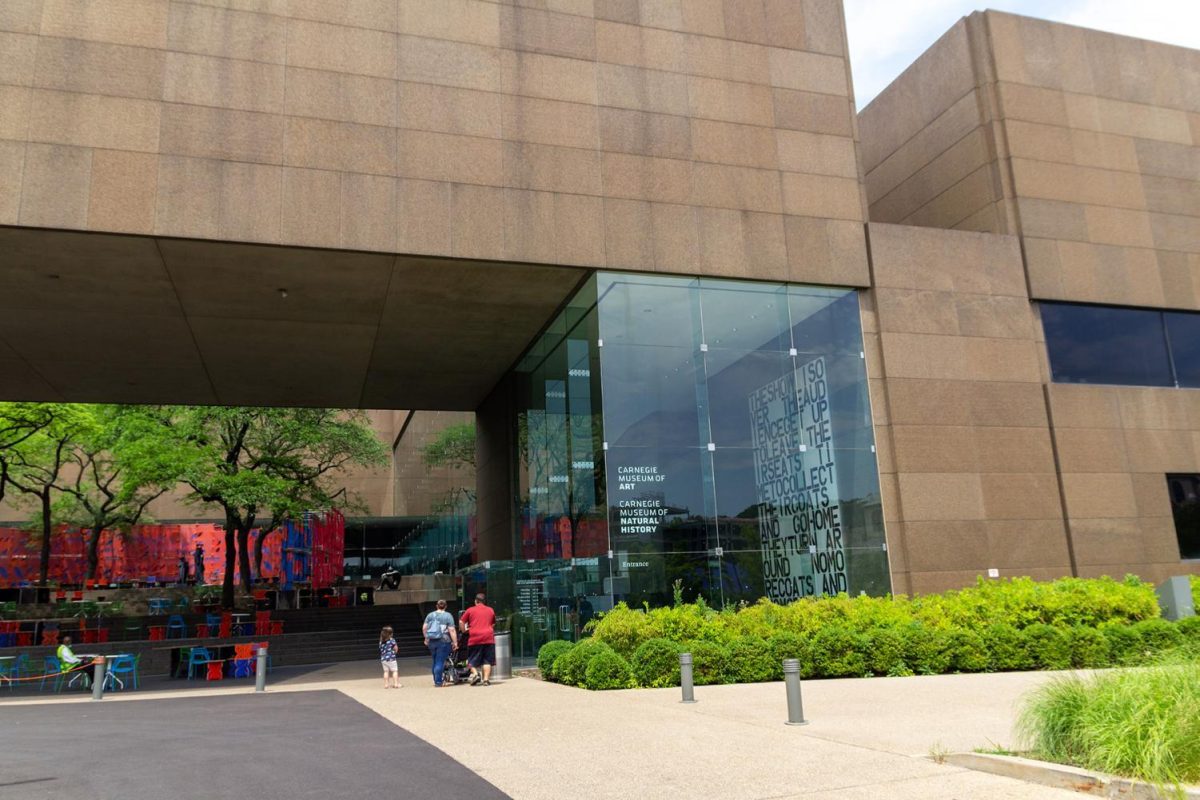Imaan Saeed had not considered art as a profession until recently. The first-year molecular biology and studio arts major won a prize at the “Envisioning a Just Pittsburgh” competition, the Carnegie Museum’s call for diverse art that “encouraged artists throughout southwestern Pennsylvania to share their visions for a just and equitable Pittsburgh.” Her artwork, titled “Dual Identities,” won first prize in the youth visual arts category.
Saeed submitted pieces from her AP Art portfolio, in which she explored her identity as a Pakistani-American through self-portraits. “Dual Identities” is a layered mixed-media piece with a black-and-white background made with linoleum block printing. Layered on top are two self-portraits, one of Saeed in a shalwar kameez, a traditional garment from South and Central Asia, and another of her replica in a beige T-shirt.
They stare at each other, hands side by side, close but never touching. Saeed doesn’t blend all the hues or cover all the space with color. Instead, she utilizes the negative space to her benefit to make her skin’s tones more noticeable, the gold of her dress shine brighter or even make a point towards intersecting identities.
“I purposely left the hair uncolored of my double self-portrait where I am wearing my cultural clothing because I thought if I colored it, it would clash too much — I kinda wanted to show the disconnect that I have with my culture,” Saeed said.
She said her dark maroon and black curly hair, noticeable on the artwork, was also a way for her to celebrate her features.
“I have naturally curly hair and, to be honest, that wasn’t something that was celebrated in my family because … because the beauty standard [in Pakistan] is straight sleek hair,” Saeed said.
The Carnegie Museums of Pittsburgh, Carnegie Library of Pittsburgh, the University of Pittsburgh, 1Hood Media and the August Wilson African American Cultural Center organized the competition. More than 120 artists in the Pittsburgh area submitted their work, including painted art pieces, choreographed performances, interdisciplinary works, poems and sonnets, collages and short stories. The winners received monetary prizes and will see their work exhibited in the Carnegie Museum of Natural History, Hillman Library and at three Carnegie Library branches.
Gina Winstead, Carnegie Museum’s first-ever vice president for inclusion, diversity, equity and accessibility, headed the project. The mission of the team is not just to make the museums more inclusive, but to feature the community of creatives in Pittsburgh. Winstead, who is also a Pitt alumna and a Pittsburgh native, wanted the competition to showcase local talent.
“The competition came from wanting to create an avenue for artists from all backgrounds to have an opportunity to be featured in the Carnegie Museums and seen by our patrons,” Winstead said. “We bring in artists from around the world that are diverse, but we don’t always see local artists represented. We also wanted to hear from our artists since they are creative and innovative around solving problems of equity.”
Winstead said these approaches to the community are not new — they come from a desire to retain the Pittsburgh creative community.
“There has been a problem in Pittsburgh of investing in diverse talent from outside the region … This drove me to do the work for DEIA,” Winstead said. “We want to make sure that we are doing this work authentically, and we want to build authentic relationships that are not forced and are symbiotic — they have a need, we listen, we have a need, they listen.”
Pitt was key in bringing in a diverse participation. Its Center for Creativity was one of the main collaborators for the past two competitions. Kit Ayars, director of the center and a member of the competition’s planning board, said creativity was fundamental for enabling personal and collective growth.
“We also recognize that engaging in creativity on one’s own can be a way to restore an individual’s heart, to regain strength and perspective,” Ayars said. “Some people do that by hanging out with others in one of our workshops.”
While neither Ayars nor Winstead judged Saeed’s work, Ayars said it caught their eye after the winners were announced.
“We were all struck by the richness of Imaan’s pieces and wound up having an enjoyable discussion of all that we were noticing or discovering in the work the longer we spent time with it,” Ayars said.



